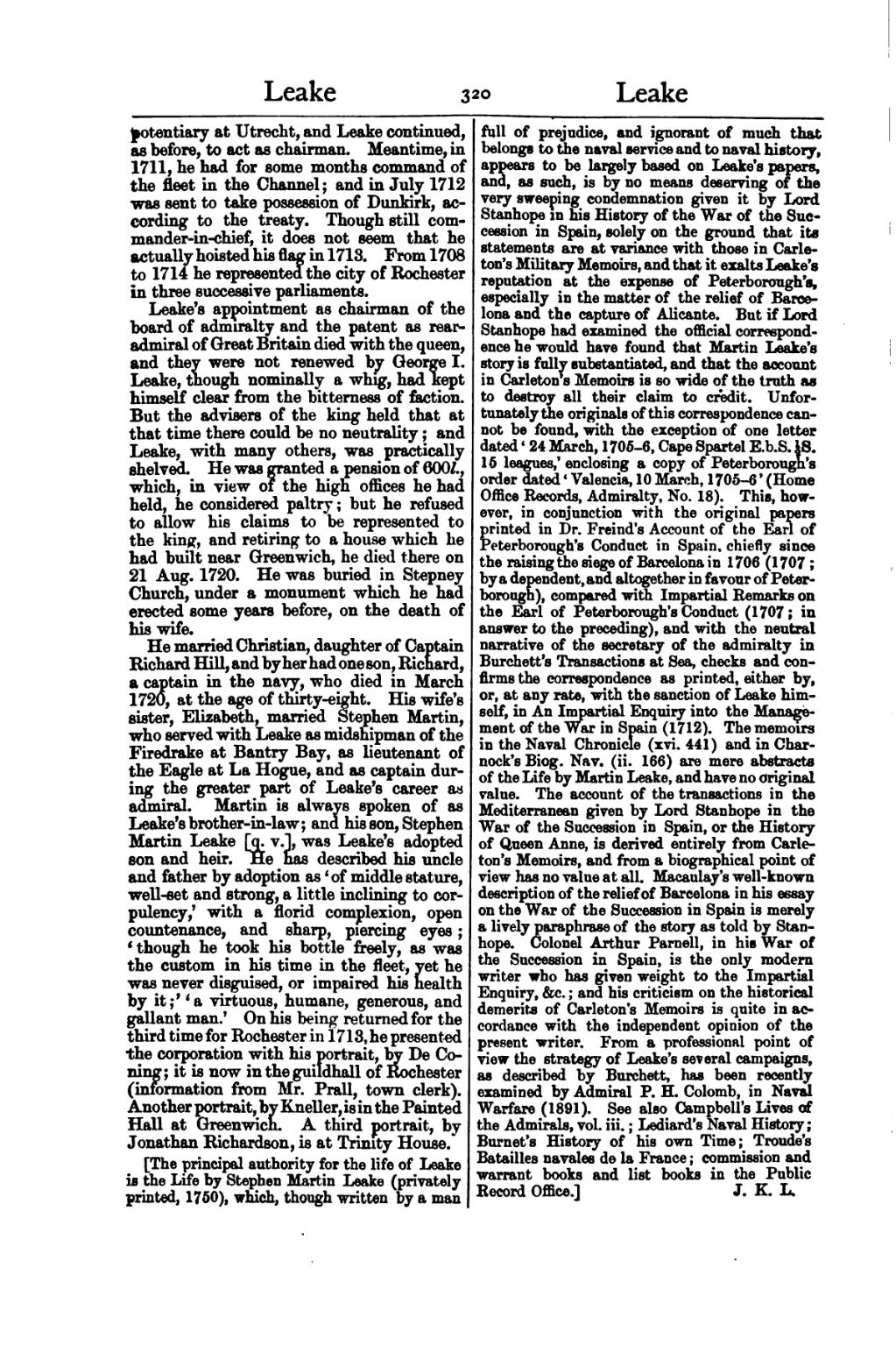potentiary at Utrecht, and Leake continued,
as before, to act as chairman. Meantime, in
1711, he had for some months command of
the fleet in the Channel ; and in July 1712
was sent to take possession of Dunkirk, according to the treaty. Though still commander-in-chief, it does not seem that he
actually hoisted his flag in 1713. From 1708
to 1714 he represented the city of Rochester
in three successive parliaments.
Leake's appointment as chairman of the board of admiralty and the patent as rear-admiral of Great Britain died with the queen, and they were not renewed by George I. Leake, though nominally a whig, had kept himself clear from the bitterness of faction. But the advisers of the king held that at that time there could be no neutrality ; and Leake, with many others, was practically shelved. He was granted a pension of 600l., which, in view of the high offices he had held, he considered paltry ; but he refused to allow his claims to be represented to the king, and retiring to a house which he had built near Greenwich, he died there on 21 Aug. 1720. He was buried in Stepney Church, under a monument which he had erected some years before, on the death of his wife.
He married Christian, daughter of Captain Richard Hill, and by her had one son, Richard, a captain in the navy, who died in March 1720, at the age of thirty-eight. His wife's sister, Elizabeth, married Stephen Martin, who served with Leake as midshipman of the Firedrake at Bantry Bay, as lieutenant of the Eagle at La Hogue, and as captain during the greater part of Leake's career as admiral. Martin is always spoken of as Leake's brother-in-law ; and his son, Stephen Martin Leake [q. v.], was Leake's adopted son and heir. JEe has described his uncle and father by adoption as ' of middle stature, well-set and strong, a little inclining to corpulency,' with a florid complexion, open countenance, and sharp, piercing eyes ; 'though he took his bottle freely, as was the custom in his time in the fleet, yet he was never disguised, or impaired his health by it;' 'a virtuous, humane, generous, and gallant man.' On his being returned for the third time for Rochester in 1713, he presented the corporation with his portrait, by De Coning ; it is now in the guildhall of Rochester (information from Mr. Prall, town clerk). Another portrait, by Kneller, is in the Painted Hall at Greenwich. A third portrait, by Jonathan Richardson, is at Trinity House.
[The principal authority for the life of Leake is the Life by Stephen Martin Leake (privately printed, 1750), which, though written by a man roll of prejudice, and ignorant of much that belongs to the naval service and to naval history, appears to be largely based on Leake's papers, and, as such, is by no means deserving of the very sweeping condemnation given it by Lord Stanhope in his History of the War of the Succession in Spain, solely on the ground that its statements are at variance with those in Carleton's Military Memoirs, and that it exalts Leake's reputation at the expense of Peterborough's, especially in the matter of the relief of Barcelona and the capture of Alicante. But if Lord Stanhope had examined the official correspondence he would have found that Martin Leake's story is fully substantiated, and that the account in Carleton s Memoirs is so wide of the truth as to destroy all their claim to credit. Unfortunately the originals of this correspondence cannot be found, with the exception of one letter dated 24 March, 1705-6, Cape Spartel E.b.S. IS. 15 leagues,' enclosing a copy of Peterborough's order dated 'Valencia, 10 March, 1705-6' (Home Office Records, Admiralty, No. 18). This, however, in conjunction with the original papers printed in Dr. Freind's Account of the Ean of Feterborough's Conduct in Spain, chiefly since the raising the siege of Barcelona in 1706 (1707 ; by a dependent, and altogether in favour of Peterborough), compared with Impartial Remarks on the Earl of Peterborough's Conduct (1707; in answer to the preceding), and with the neutral narrative of the secretary of the admiralty in Burchett's Transactions at Sea, checks and confirms the correspondence as printed, either by, or, at any rate, with the sanction of Leake himself, in An Impartial Enquiry into the Management of the War in Spain (1712). The memoirs in the Naval Chronicle (xvi. 441) and in Charnock's Biog. Nav. (ii. 166) are mere abstracts of the Life by Martin Leake, and have no original value. The account of the transactions in the Mediterranean given by Lord Stanhope in the War of the Succession in Spain, or the History of Queen Anne, is derived entirely from Carleton's Memoirs, and from a biographical point of view has no value at all. Macaulay's well-known description of the relief of Barcelona in his essay on the War of the Succession in Spain is merely a lively paraphrase of the story as told by Stanhope. Colonel Arthur Parnell, in his War of the Succession in Spain, is the only modern writer who has given weight to the Impartial Enquiry, &c. ; and his criticism on the historical demerits of Carleton's Memoirs is quite in accordance with the independent opinion of the present writer. From a professional point of view the strategy of Leake's several campaigns, as described by Burchett, has been recently examined by Admiral P. H. Colomb, in Naval Warfare (1891). See also Campbell's Lives of the Admirals, vol. iii. ; Lediard's Naval History; Burnet's History of his own Time; Troude's Batailles navales de la France ; commission and warrant books and list books in the Public Record Office.]
